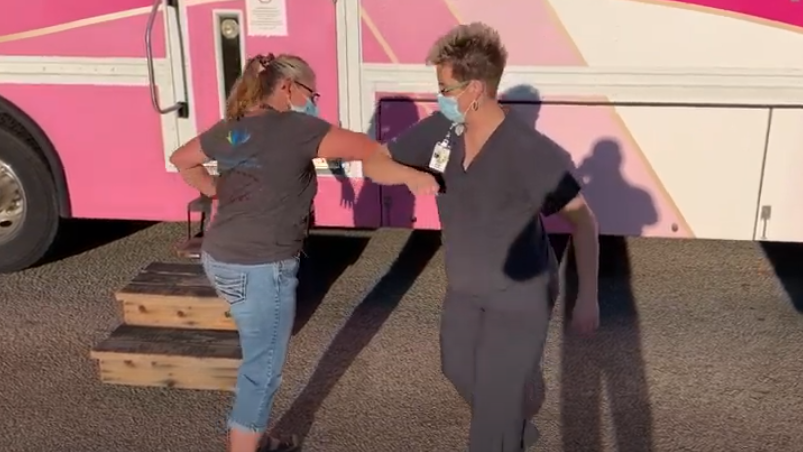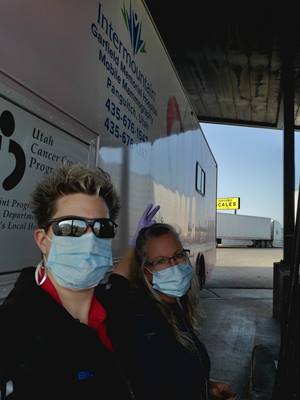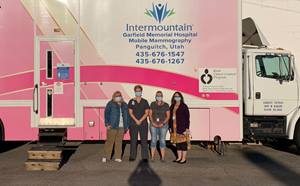By David Jensen, Intermountain’s operations director for community care imaging and mammography

Intermountain currently operates two mobile mammography services, one in the northern part of the state and one in the south. The northern mobile unit was scheduled to be at the Seager Memorial Clinic in Ogden on Saturday, September 12, for a health fair that would provide free healthcare services to low- and no-income patients — including the homeless population in and around the Ogden area.
Sonya Dexter, our northern mobile mammography coordinator, had been working for months with Chelsea Slade, MD, the center’s medical director, and Ruth Brockman, Seager Memorial coordinator and board member, to coordinate the event. The new mobile mammography service was to be the center piece of the women’s health portion of the event by providing free mammograms, thanks to the Utah Cancer Control Program and donated funds from the Susan G. Komen Foundation. In addition to screening mammography, there would be seven providers from McKay-Dee and the Ogden Clinic onsite to assist with pap smears, skin cancer screenings, lab draws and testing, colon screening, blood pressure, A1C, and other screening services. Intermountain Laboratory Service and Utah Pathology would also be involved in the event.
Unfortunately, the northern mobile mammography service experienced some equipment-related downtime and on Friday afternoon, I received word that the mobile unit wouldn’t be up and running in time for the Seager event on Saturday. This left us with either having to back out of the Seager event entirely or of attempting to sign patients up at the event for a mammogram at some future date. Neither option was great. Given the low likelihood of getting the patients to return on a specific day and time for a mammogram—especially when most don’t have transportation—I knew our best opportunity to get the most women screened would be to be present for the health fair.

Emily and Natalie stopping for gas during their long drive
I knew it was a long shot, but at 2 p.m. on Friday afternoon I called Emily Shakespeare, the lead technologist of the Garfield Mobile Mammography Service. Ever cheerful and upbeat Emily answered her phone and said, “Hey David, how are you doing?” “Not great, Emily,” I replied. “That’s why I’m calling you on a Friday afternoon.” To which Emily responded, “What can I do to help?” These six simple but powerful words were then backed up with real action, a hallmark of the work ethic and can-do attitude of our rural caregivers.
I explained the situation to Emily and, even though she’d just finished up work for the day and was preparing for a three-day mobile mammography road trip that would begin on Monday, she said, “Give me one hour to check with Natali Schoppe [their driver, breast care coordinator, and imaging clerk,] and I’ll get back to you.” It wasn’t long before both Natali and Emily were back on the phone with Sonya and I coordinating details and logistics. Their collective response was, “Yes, we’ll come.”
Emily’s husband was sitting next to her when she answered my call. He expressed his encouragement and support of Emily making the trip despite it being his birthday on Saturday. In addition, Natali has a side job as a school bus driver and had just wrapped up a long day of training a new driver and local school children about school bus safety. Yet, Natali’s response was that she was, “good to go.” Emily, Natali, and their families know the power one mammogram can have to change and potentially save a life. They’re also not strangers to service and sacrifice.

Teri Tomlinson, Emily Shakespeare, Natali Schoppe, and Sonya Dexter in front of the Garfield mobile mammo unit at the Seager Memorial Clinic health fair.
That night, Natali drove the Garfield mobile mammography truck 215 miles to Springville, where they stayed the night. The next morning, they were back on the road before 5 a.m. to finish the nearly 300-mile trip to Seager Memorial Clinic in Ogden.
Sonya and I met Emily and Natali at Seager at 7 a.m., brought them breakfast, helped them set up, and captured a priceless video of the Emily’s and Natali’s ‘mobile mammo team handshake.’ Their attitudes and positive energy were contagious. In total, the health fair provided services to about 30 patients, many of whom received a mammogram. Then Natali and Emily hit the road back to Garfield on Sunday morning.
I’m grateful for and humbled by Emily’s and Natali’s response to my call for help. I’m also grateful for Sonya Dexter, Teri Tomlinson, Alberto Vasquez, Heidi Warner, and Brady Eyre for supporting the Garfield team in making an almost 600-mile round-trip to save the day. Because of Emily’s and Natali’s efforts, we were able to keep an important commitment to the Seager Memorial Clinic and, more importantly, to serve some of our most vulnerable community members. Hats off and a very big thank you to Emily and Natali for making this happen. What an incredible team.

